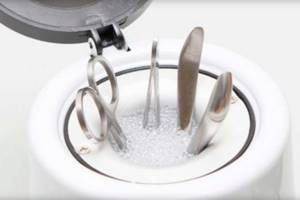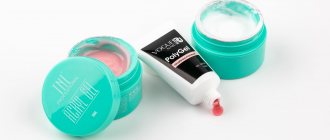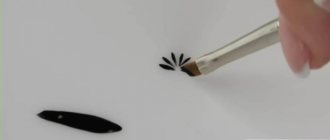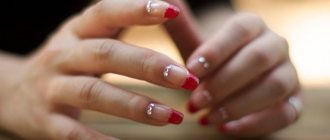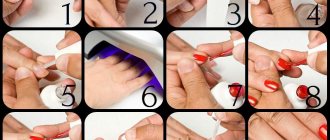Brush SPA program
Whatever cleaning product you choose, the “washing” technique is the same and requires gentleness and accuracy. This is the second 50% of success. Clean your gel polish brushes in a few simple steps:
- Pour a small amount of cleaning liquid into a glass container, preferably a flat one.
- Using light pressure on the handle, press the brush to the bottom with different sides, washing away the remaining gel polish.
- Rinse your brush with water.
- Gently blot any remaining moisture between paper towels.
- Use your fingers to give the tip its original shape.
- Dry the instrument completely and only then store it.
It is better to store brushes in a special case, fixing them in a horizontal position. In this case, the likelihood of moisture getting into the clip is minimal, which is guaranteed to protect against softening of the glue and premature hair loss. When transporting, craftsmen recommend wearing additional caps with air holes.
Before using a new brush, you need to clean it of any remnants of the special factory glue that gives it the desired shape. Beat the lint on a clean paper towel until it softens. If necessary, rinse the bristles with warm running water. The tool is now ready for use.
Brussels manicurius
The look is simple, the class is creative. Consists of three parts: bristles, clip and handle.
- Bristle. Hair can be natural or synthetic. Choose the one that your wallet allows you to take. Artificial bristles are in no way inferior in quality to natural bristles if the brush is made to last. New generation synthetics sometimes cope better with the tasks and are characterized by good durability and strength. The bristles should be soft and elastic; hard and rough bristles will not allow you to apply the polish evenly on the nail and create patterns.
- Clip. A funny name for the metal clamp that connects the bristles to the handle. It should be strong and tightly compressed, which will protect the hairs from falling out during work and will not allow the brush to fluff up.
- Pen. Doesn't affect anything except price. Wood or plastic. Status or economy.
How to choose brushes
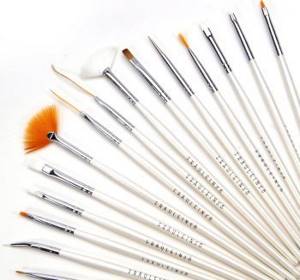
Set of brushes
It is advisable to give preference to brushes made from natural materials. They are more expensive, but they are of good quality and will last a long time. These brushes can be used to create patterns of any complexity.
Also pay attention to convenience. The brush should be the right size for you and fit well in your hand.
If you have no preferences in nail design, it is better to purchase brushes in a set. Typically, manufacturers offer an optimal selection of 3, 5 or 12 brushes.
Online stores offer a huge selection of nail design brushes. To ensure that you are buying a quality instrument, always check the quality certificates.
The mouse ran and waved its tail...
The brush with gel polish rolled and fell directly under the rays of the curing lamp. It hardened and upset the owner. Don't be upset, all is not lost yet. The patient can be resuscitated:
- Soak the brush in the cleaner for 15 minutes, keeping it in a vertical position.
- Place the bristles on a flat surface and apply a little pressure to form a fan shape.
- Armed with an orange stick, gradually remove the softened particles of gel polish.
- Then do the same - rinse with water, blot, shape, dry and hide.
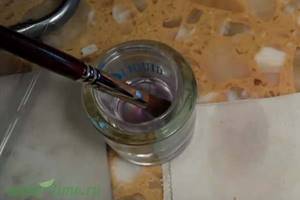
Have an educational conversation with the mouse on the topic of running in the wrong place.
Classification, types
There are several criteria by which manicure brushes are classified.
The first criterion is the material from which the tools are made.
- Natural . Natural villus has a porous structure, with a cuticular layer. Such a brush holds the material on itself longer and releases it more slowly into the drawing, so with such brushes it is more convenient to paint watercolors, shade, apply shadows, and just draw calmly and slowly. They are the most expensive, but quickly deteriorate due to acetone-based products.
- Synthetic or nylon. Synthetics have smooth pile, i.e. Each individual fiber is smooth. When we paint with a synthetic brush, the material from it quickly flows onto the nail plate and leaves a mark, so for gel paint we use synthetics, which can quickly draw lines and pattern elements.
- Mixed . The dome of the brush contains natural and synthetic bristles.
The next important criterion is the thickness of the pile in the dome.
- To create a three-dimensional design and large elements, you need a thick brush.
- For delicate lines and patterns, the thinnest brush is needed.
They are numbered depending on the thickness of the fibers. The higher the number indicated, the thicker the brush. The thinnest ones are designated 0, 00, 000 - hair or ultra-thin, and the thickest or widest instruments have the number 8 in the designation.
Each brush must have a designation indicating the thickness of the bristles and the material.
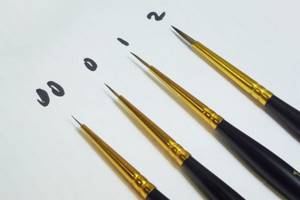
Brushes can also be divided according to their purpose:
- For varnish . With their help, applying nail polish is much more convenient than with a brush, which is sold with the bottle. You can choose the thickness and length of the beam yourself.
- For acrylic . A tool with hard, rounded bristles and a pointed end. It is with its help that acrylic powder is laid out.
- For the gel . Brushes with a square or rectangular dome shape, flat, with hard bristles. The combination of these factors allows you to conveniently work with biogel when covering nail plates and easily model nails from a viscous gel during the extension process.
- For nail design - nail art, painting. Designed for drawing patterns, sculpting three-dimensional decor, and artistic painting.
The next factor influencing the choice is the shape of the dome. There are several main types of brushes, each of which performs specific functions.
- Liner , striper or hair.
A brush with a thin, no more than 2 mm, tuft of bristles, usually 2-3 cm long. The tool is intended for drawing details of a lace pattern, geometry, filigree curls, long lines that can be drawn continuously due to the total length of the bristles. To work with such a brush you need skill, and it is customary to use it for working with acrylic paints and gel polishes. Gel spider and spider manicure
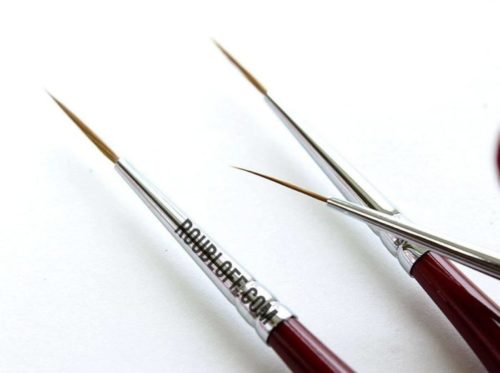
- Spot . A device for performing the smallest details of nail art. The smallest brush, size from 000 to 2, the dome shape is similar to a spade, which makes it convenient for working with small elements of the design. Only the tip of the brush is dipped into the paint and when working you need to hold it strictly vertically to the nail surface.
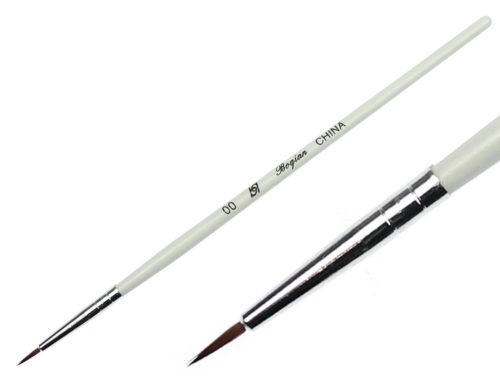
- Fan-shaped or fan-shaped. It got its name because of its appearance - the villi spread out in a semicircle. An indispensable device for creating original decor. Using this brush, you can evenly scatter glitter on your nails, apply glitter, shade the design, and create a “blurry” background. Very often, a fan-shaped tool is used to create ombre and gradient manicure on nails.
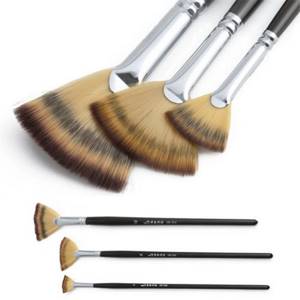
- Petal . The flat dome is narrowed towards the end, reminiscent of a petal. With certain working skills, this one manicure tool can replace two other brushes, a dotted one and an angled one, because with this brush you can draw complex patterns, openwork waves, and even apply sparkles. But most often it is used to create Chinese paintings with floral patterns.
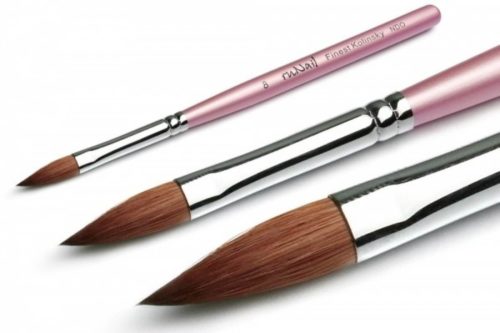
- Flat or wide.
If you are a beginner, then it is better to start practicing your technique and skills using this particular brush. It is much easier to work with than a round bone. The wide active working surface of the beam allows you to evenly apply the polish on your nails, as well as pick up several colors at the same time, thereby creating an interesting and complex pattern. Also used to create gradient, ombre or other interesting nail designs. Gradient manicure: preparation, ideas, materials, 6 methods of execution

- Dagger-shaped or beveled. This instrument has a flat dome cut at an angle of 45 degrees. This form allows you to draw the same elements of decorative manicure, create both three-dimensional drawings and subtle patterns, as well as diagonal lines of the nail plate. It’s convenient to use this brush to do a French manicure, as well as pick up several shades and apply complex decor.
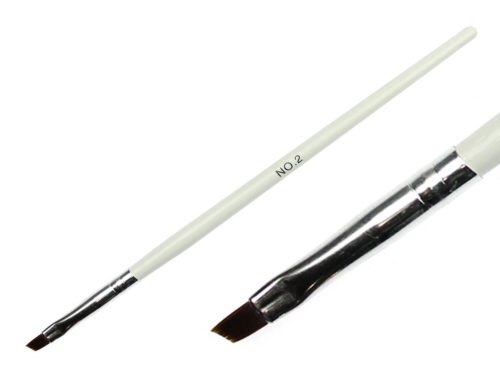
- Dots are a tool made of plastic or wood, on both ends of which there are balls that differ in diameter. To some extent, dots are related to brushes, because with its help you can draw both simple dot patterns and create Gzhel painting on your nails. If you select the required diameters of the balls, then they can replace the liner and dotting brush.
- Rounded . It resembles a wide brush, but the edges of the bristles are rounded. Instruments with this dome shape vary in pile length.
- Short pile . Convenient for drawing floral and plant patterns, because one print already produces an ideally shaped petal.
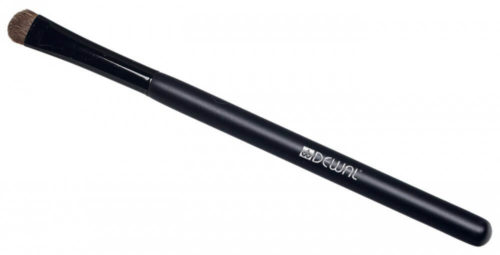
- With medium pile . Very convenient for applying varnish to the entire nail surface, modeling and making patterns of varying complexity, and filling the background.
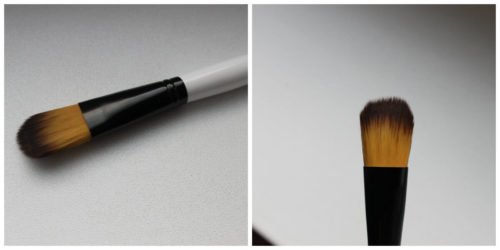
- French brush .
You can find on the shelves an invention of manufacturers of manicure accessories - a brush, the dome of which has an arched shape. With its help, it’s easy to draw the perfect “smile line” in a French manicure. Design options for a French jacket - a selection of ideas
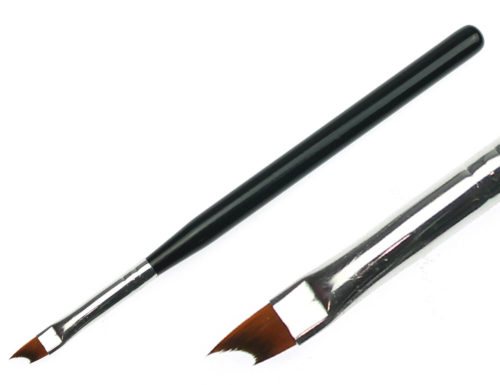
- Curly . These brushes are designed for nail design - creating a manicure with flowers, gradient or ombre. The edge of the curly tassels can be anything - torn, divided into 2-3 parts with rounding or narrowing. These brushes are optional - all their functions can replace the varieties listed above, but if you often paint on your nails, they will help make the process easier and faster.
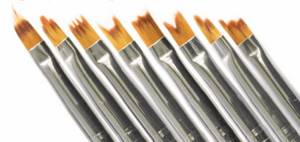
- Silicone brushes or shapers. Instead of a pile dome, such instruments have silicone tips, the shape of which can be very diverse. Shapers have an important advantage - varnishes do not spread on them, which makes work easier when creating patterns. They are also more durable than brushes with bristles.

How to use manicure brushes correctly?
Each brush has a specific area of use. For example, to create Chinese painting, choose a thin, beveled and square brush. The pile of such products can be from 3 mm to 2 cm.
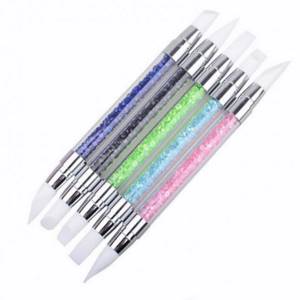
A small amount of coloring pigment is applied to the tip. After that, the working tool is fixed at one point and a smooth movement is carried out to give the desired shape.
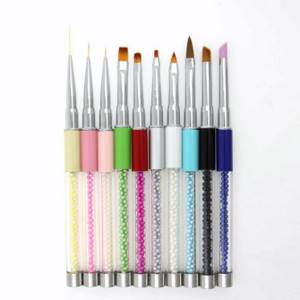
Thin brushes are used to work on individual areas. The liner has a long pile, allowing you to create a clear decor. The standard set contains 3 working tools of different lengths.
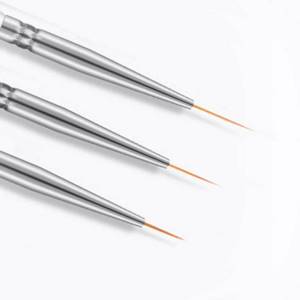
A fan brush is chosen to perform gradient techniques, abstraction, and even distribution of shiny decor. To make a smooth transition, it is enough to carefully distribute the colorful composition over the entire area of the nail using point movements.
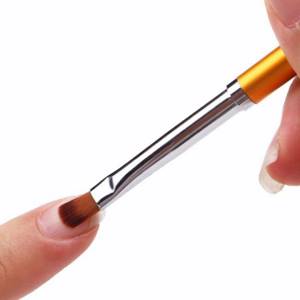
To prevent glitter from accumulating in one area, the wide fleecy part is dipped into shiny decor and distributed throughout the design using tapping movements.
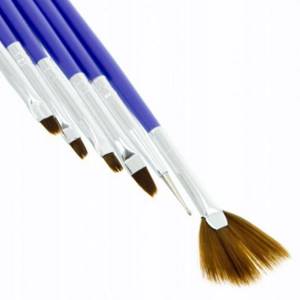
How to sterilize instruments at home?
What to do if it is not possible to purchase a dry heater or an autoclave? There is an alternative! Salon equipment can be replaced by a miniature and more affordable device - a glasperlen (ball) sterilizer. It is a container filled with small balls that are heated to high temperatures (230-240 degrees). The instruments are lowered into this device and completely disinfected.
|
The balls are heated from a regular electrical outlet. The Glasperlene sterilizer must be warmed up in advance. When it is ready to load tools, a special light will light up. Tools are processed very quickly - less than a minute! This is a big plus, but there are also disadvantages. The device is not suitable for everything; only miniature tools can be processed in it: files, pliers, scissors. In addition, only the main part of the instrument is lowered, and its handle sticks out and remains without sterilization.
Quartz ball sterilizer RU-505 ruNail
MACROSTOP glasperlene sterilizer, ball Planet Nails
Another method of sterilizing instruments at home is processing in a conventional oven. A double boiler or slow cooker is also suitable for this purpose. Please note that this method is considered obsolete and is undesirable. An oven is more suitable if you only do your own manicure. Firstly, it is saturated with food odors, residual fats and dirt, which is bad for sterilization. Secondly, complete tightness cannot be guaranteed.
And yet, if you have to use the oven, how to do it correctly? Let's assume you've already cleaned your tools and disinfected them.
1. Preheat the oven to 180-200 degrees. Prepare tools, a baking sheet, metal tongs or large tweezers, oven mitts and oven mitts. 2. Place the tools on a baking sheet so that they do not touch, and place them in the oven for 13-15 minutes. 3. Using oven mitts and oven mitts, remove the baking sheet and let the tools cool.
ATTENTION!
This method is only suitable for metal tools. Do not place sand-coated cardboard or plastic files in the oven!
We looked at ways to sterilize instruments, but it is equally important to store them correctly, otherwise there is no point in processing them. If you put sterile instruments in an open drawer, they will quickly become covered with dust particles and will no longer be suitable for use.
How to dilute matte nail polish?
- Matte nail polish is essentially no different from glossy polishes. Therefore, any means for diluting regular varnish are suitable for it.
- Since the matte finish is very capricious, you should not experiment. The best solution is to use a special varnish thinner
- Matte varnish quickly loses its dullness and chips. It is better to apply it in 2-3 layers and dry naturally for at least an hour
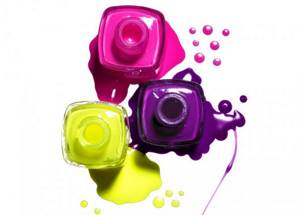
How to dilute matte nail polish?
What does a brush consist of?
A brush is a manicure tool designed for painting, sculpting and decorating nails using varnishes, paints, and decorative elements.
Any brush consists of three parts:
- Pen . Usually made of high-quality, durable and pleasant-to-touch polymer material or wood.
- Crimp ring , clip or cartridge - a metal holder that attaches the hair bundle to the handle and securely fixes it.
- A bun is a collection of hairs into one solid dome.
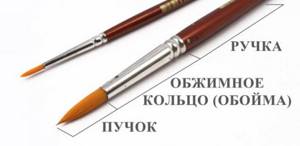
Classification of manicure brushes according to material, bristle thickness and shape.
Based on their material, they can be divided into two types:
- natural
- artificial
Natural manicure brushes are made from sable wool or, most often, from kolonka (a fur-bearing animal of prey). With proper care, they last a long time and have excellent pile, which allows them to be used for any type of paint. Kolinsky brushes can be distinguished by their golden-brown bristles. Artificial ones are made from high-quality polymers (nylon, etc.). There are no particular differences in the use and care of these brushes, it’s just that synthetic ones are cheaper, but last less, so they are recommended for beginners to purchase for the first time.
Based on the thickness of the pile and its shape, a certain numbering is generally accepted:
- 0 (or 00) is the thinnest brush for painting
- 8 – the largest, it is more recommended for modeling
Tips for using manicure brushes
- Use brushes strictly for their intended purpose. If the brush is used incorrectly, hairs may fall out of it and it may become deformed.
- Never leave tools in water or chemicals. This may cause the work area to become deformed.
- Do not leave paint on tools; wash them after each use.
- To prevent the lint from rubbing off, use only smooth materials for the palette.
After each use, lubricate the hair of the tool with cuticle oil. This will protect the brush from drying out and deformation.
Following these simple rules will lead to long-term service for your brushes.
